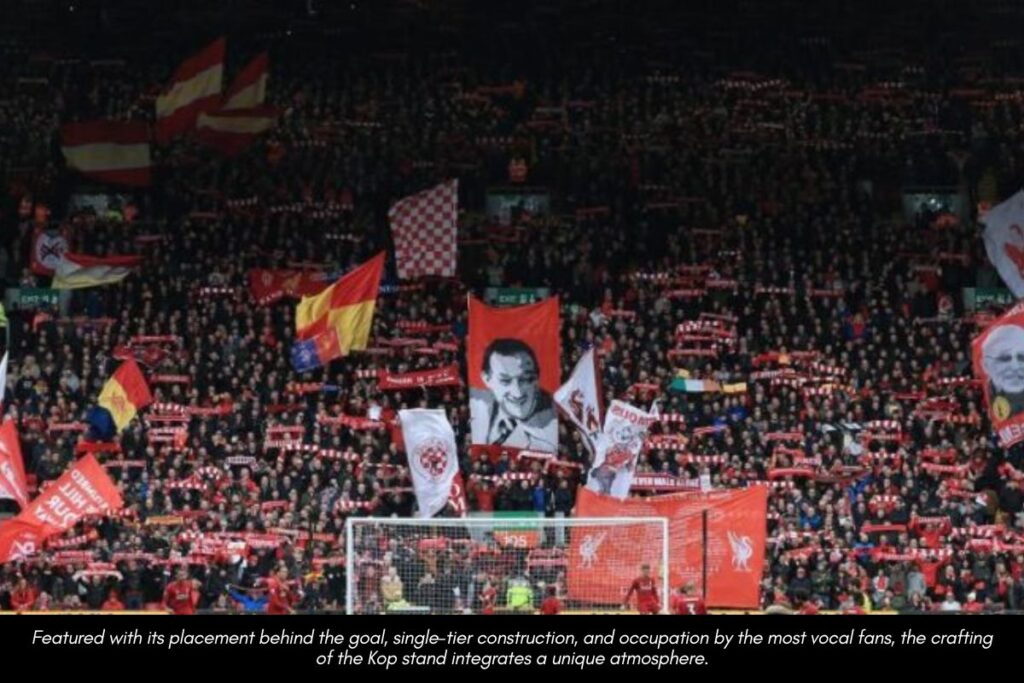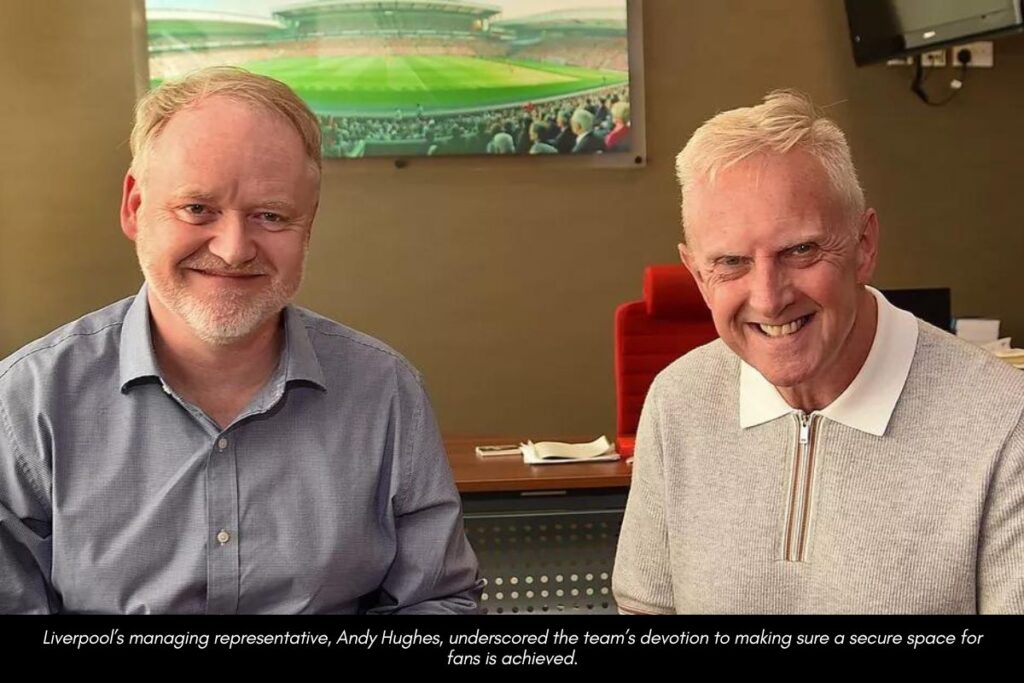Anfield situated in Liverpool and housing the Kop Stand Anfield, is a football stadium and a home to Liverpool FC since their establishment in 1892. Featuring four stands, – the Spion Kop, Main Stand, Centenary Stand, and Anfield Road End. The Stadium hosted a one-time high attendance of at least 61,900, during the match between the Reds and Wolverhampton Wanderers in 1952. Converted to an all-seater stadium in 1994 after the Taylor Report, the stadium significantly reduced the seating capacity therefore affecting the seating plan of the four stands.
What the Kop Stand Anfield Means for Liverpool
When contemplating the most popular soccer stands across the world, familiar contenders linger in mind. Dortmund’s Yellow Wall, Old Trafford Stretford End, and Boca Juniors’ North regularly dominate the discussion. However, amid these titans of supporter fervor stands Liverpool’s Anfield, taking pride in its iconic section: The Kop. The Kop Stand Anfield Liverpool admittedly, may strike as unique for a European Stand.
The Stand’s origin is traced back unexpectedly to a battlefield in South Africa, more than 100 years ago. In the middle of the Boer War, British forces clashed in a bid to secure a hilltop, in the end seeing the loss of 300 able soldiers in the endeavor. Many came from Lancashire, especially Liverpool. The hilltop bore a name that would sound through time: Spion Kop – or Spioenkop in South African dialect.
How Many Seats are in the Kop at Anfield?
In the year 1906, as Liverpool endeavored to position a new stand made from cedar and brick, a local sports editor, Ernest Edwards, drew a poignant link. Witnessing the stand’s layout to the battlefield where many local men had met their deaths, he christened it the Spion Kop. This moniker, though not formally embraced until 1928, profited from official recognition as the stand expanded to house 27,000 fans, complete with a cantilever roof.
While other clubs have embraced the design, lending their stands names like the Kop, including Leeds United, Notts County, Leicester City, and teams abroad like Paris Saint Germain in France and De Graafschap in the Netherlands, none compete the original Kop at Liverpool Football Club hallowed ground. Featured with its placement behind the goal, single-tier construction, and occupation by the most vocal fans, the crafting of the Kop stand integrates a unique atmosphere.

However, the tragedy set a core juncture in its history. Following the Hillsborough calamity in 1989, which claimed at least 96 lives of Liverpool faithful, including numbers from the Spion Kop, extensive renovations were implemented, redesigning the physical space while retaining its lasting spirit.
Gordon and Bill Honored by the Kop
Goalkeeper Gordon Banks rose to National hero status after helping England win the World Cup. Besides Gordon’s brilliance regularly preventing Liverpool endeavors, Anfield fans always welcomed him. Upon his retirement in 1973, an interesting event unfolded at Anfield when legendary manager Bill Shankly surprised Gordon. Leading him towards the Spion Kop stand, Bill Shankly orchestrated a heartfelt tribute. The Kop, popular for its passionate support, erupted in an emotional final salute, showering Gordon and Bill with adulation. During this event, the goalkeeper and the manager shared a connection triggered by mutual respect and desire, immortalized in the middle of the fervent roars of Liverpool’s devoted faithful.
Kop Stand Anfield: The Impact of Safe Standing
With the establishment of rail seating, Anfield’s iconic Spion Kop stand was marked to go through a transformative process, something that will represent an estimated 55 percent of its total capacity. Popular for its passionate and vocal fans, the Kop stand positions itself as a symbol of Liverpool’s fervent support base. Additionally, the squad has outlined plans to further stretch the availability of rail seats within the stand, promising a more dynamic game day experience for the supporters.
Liverpool’s Chase for a Safe Standing License
In correlation to the recommendations from the Sports Ground Safety Authority, SGSA, the club is actively chasing a Safe Standing License. It’s an initiative that places the squad among a select group of Premier League teams, consisting of Brentford, Chelsea, Manchester City, Manchester United, Tottenham, and Wolves, who have already gotten the licenses for their respective stadiums.

Liverpool’s managing representative, Andy Hughes, underscored the team’s devotion to making sure a secure space for fans is achieved. After a thorough visit to the rail seating test, the director asserted its success and permanent integration into Anfield stadium. Stressing the club’s unshaken devotion to supporters’ safety, Andy reiterated that such a priority remains paramount in ugly incidences such as what had happened in Hillsborough.
In the 2021 review, the Sports Ground Safety Authority noted some matters of persistent standing among fans in the Kop and other stands like Anfield Road End. The proposed installation of rail seats aimed at mitigating such concerns in the right way, therefore providing an answer that balances supporters’ happiness, and confidence with safety procedures ultimately improving the game day experience for all Liverpool faithful.
The Bottom Line
In conclusion, the Spion Kop stand shines as more than just a section of seating within Anfield Stadium. It’s a section that integrates a legacy of passion, faithfulness, and togetherness among the spectators. From the stand’s humble beginning as a tribute to fallen soldiers to its transition into a sign of unshaken commitment to Liverpool Football Club, the Spion Kop has gone beyond its physical structure to become a key aspect of the footballing culture. With its popular atmosphere, triggered by the fervent cheers, chants, and the unspeakable support of supporters, the stand has seen victories and calamities, however, its spirit remains unyielding.
As Anfield goes on to change and adapt to the current and modern standards, this part of the field displays a testament to the everlasting link between a team and its fans. It serves as a rallying point, a fountain of motivation, and a reminder of the strength of community in the space of soccer. Whether triumphing wins or weathering shortcomings, the Kop remains a symbol of hope and oneness, uniting generations of supporters in their shared love for the beautiful match of the squad they proudly call their own.
Find the Latest News on Player Ratings | Transfers | Prematch | Postmatch
Stay tuned for more updates on Liverpool FC Times and Stories. Your thoughts are always welcome in the comments section. Thank you for your continued support!
YNWA (You’ll Never Walk Alone)!
The Liverpool FC Times Team
LiverpoolFCTimes.com
